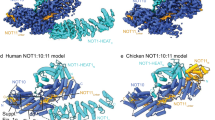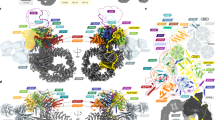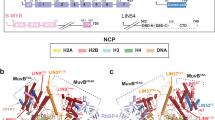Abstract
The Maf family proteins, which constitute a subgroup of basic region-leucine zipper (bZIP) proteins, function as transcriptional regulators of cellular differentiation. Together with the basic region, the Maf extended homology region (EHR), conserved only within the Maf family, defines the DNA binding specific to Mafs. Here we present the first NMR-derived structure of the DNA-binding domain (residues 1–76) of MafG, which contains the EHR and the basic region. The structure consists of three α-helices and resembles the fold of the DNA-binding domain of Skn-1, a developmental transcription factor of Caenorhabditis elegans. The structural similarity between MafG and Skn-1 enables us to propose a possible mechanism by which Maf family proteins recognize their consensus DNA sequences.
This is a preview of subscription content, access via your institution
Access options
Subscribe to this journal
Receive 12 print issues and online access
$189.00 per year
only $15.75 per issue
Buy this article
- Purchase on Springer Link
- Instant access to full article PDF
Prices may be subject to local taxes which are calculated during checkout




Similar content being viewed by others
References
Motohashi, H., Shavit, J.A., Igarashi, K., Yamamoto, M. & Engel, J.D. NucleicAcids Res. 25, 2953–2959 (1997).
Blank, V. & Andrews, N.C. Trends Biochem. Sci. 22, 437–441 (1997).
Motohashi, H., Katsuoka, F., Shavit, J.A., Engel, J.D. & Yamamoto, M. Cell 103, 865–875 (2000).
Kataoka, K. et al. Mol. Cell. Biol. 15, 2180–2190 (1995).
Kataoka, K., Fujiwara, K.T., Noda, M. & Nishizawa, M. Mol. Cell. Biol. 14,7581–7591 (1994).
Kerppola, T.K. & Curran, T. Oncogene 9, 3149–3158 (1994).
Wishart, D.S. & Sykes, B.D. Methods Enzymol. 239, 36–81 (1994).
Farrow, N.A. et al. Biochemistry 33, 5984–6003 (1994).
Harper, E.T. & Rose, G.D. Biochemistry 32, 7605–7609 (1993).
Wintjens, R. & Rooman, M. J. Mol. Biol. 262, 294–313 (1996).
Lo, M.C., Ha, S., Pelczer, I., Pal, S. & Walker, S. Proc. Natl. Acad. Sci. USA 95, 8455–8460 (1998).
Rupert, P.B., Daughdrill, G.W., Bowerman, B. & Matthews, B.W. Nature Struct. Biol. 5, 484–491 (1998).
Ellenberger, T.E., Brandl, C.J., Struhl, K. & Harrison, S.C. Cell 71, 1223–1237 (1992).
Glover, J.N. & Harrison, S.C. Nature 373, 257–261 (1995).
Delaglio, F. et al. J. Biomol. NMR 6, 277–293 (1995).
Garrett, D.S., Powers, R., Gronenborn, A.M. & Clore, G.M. J. Magn. Reson. 95,214–220 (1991).
Sattler, M., Schleucher, J. & Griesinger, C. Prog. NMR Spect. 34, 93–158 (1999).
Neri, D., Szyperski, T., Otting, G., Senn, H. & Wüthrich, K. Biochemistry 28,7510–7516 (1989).
Tomomori, C. et al. Nature Struct. Biol. 6, 729–734 (1999).
Vuister, G.W. & Bax, A. J. Am. Chem. Soc. 115, 7772–7777 (1993).
Nilges, M., Clore, G.M. & Gronenborn, A.M. FEBS Lett. 229, 317–324 (1988).
Brünger, A.T. X-PLOR version 3.1: A system for X-ray crystallography and NMR (Yale University Press, New Haven; 1993).
Koradi, R., Billeter, M. & Wüthrich, K. J. Mol. Graph. 14, 51–55 (1996).
Kraulis, P.J. J. Appl. Crystallogr. 24, 946–950 (1991).
Merritt, E.A. & Bacon, D.J. Methods Enzymol. 277, 505–524 (1997).
Nicholls, A., Sharp, K.A. & Honig, B. Proteins 11, 281–296 (1991).
Azam, T.A. & Ishihama, A. J. Biol. Chem. 274, 33105–33113 (1999).
Johnson, M.L., Correia, J.J., Yphantis, D.A. & Halvorson, H.R. Biophys. J. 36, 575–588 (1981).
Laue, T.M., Bhairavi, D.S., Ridgeway, T.M. & Pelletier, S.L. In Analytical ultracentrifugation in biochemistry and polymer science (eds Harding, S.E., Rowe, A.J. & Horton, J.C) 90–125 (Royal Society of Chemistry, London; 1992).
Brooks, B.R. et al. J. Comp. Chem. 4, 187–217 (1983).
Laskowski, R.A., Rullmann, J.A.C., MacArthur, M.W., Kaptein, R. & Thornton,J.M. J. Biomol. NMR 8, 477–486 (1996).
Acknowledgements
We thank E. Arai and F. Arisaka for ultracentrifuge analysis, T. Maeda for useful discussion, K. Yap for providing a program to calculate interhelical angles and T. O'Connor for critical reading of the manuscript. This work was supported by grants from JSPS and TARA (T.T.); the Ministry of Education, Science, Sports and Culture of Japan (H.M. and M.Y.); JSPS and CREST (M.Y.); and PROBRAIN (H.M.).
Author information
Authors and Affiliations
Corresponding author
Ethics declarations
Competing interests
The authors declare no competing financial interests.
Rights and permissions
About this article
Cite this article
Kusunoki, H., Motohashi, H., Katsuoka, F. et al. Solution structure of the DNA-binding domain of MafG. Nat Struct Mol Biol 9, 252–256 (2002). https://doi.org/10.1038/nsb771
Received:
Accepted:
Published:
Issue Date:
DOI: https://doi.org/10.1038/nsb771
This article is cited by
-
The role and regulation of Maf proteins in cancer
Biomarker Research (2023)
-
Expedient chemical synthesis of 75mer DNA binding domain of MafA: an insight on its binding to insulin enhancer
Amino Acids (2012)
-
A new MAFia in cancer
Nature Reviews Cancer (2008)
-
A structure-based method for identifying DNA-binding proteins and their sites of DNA-interaction
Journal of Structural and Functional Genomics (2005)
-
A structure-based method for identifying DNA-binding proteins and their sites of DNA-interaction
Journal of Structural and Functional Genomics (2004)



